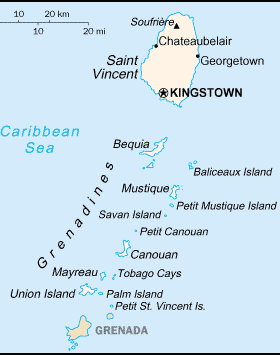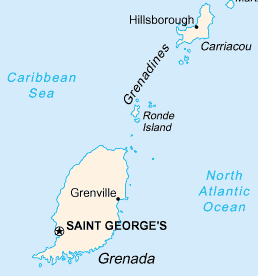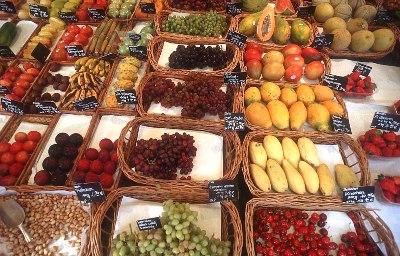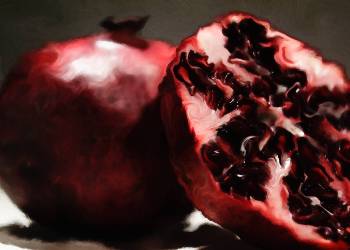|
Number 779, 2005 by DeAnna Coon |
|
General
Information Legal Cluster Bio-Geographic Cluster Trade Cluster Environment Cluster Other Clusters |
|
|
|||
 |
|||
|
Number 779, 2005 by DeAnna Coon |
|
General
Information Legal Cluster Bio-Geographic Cluster Trade Cluster Environment Cluster Other Clusters |
|
|
|||
 |
|||

 I. Identification
I. Identification1. The Issue

Random House Webster’s Dictionary defines “grenadine” as “a syrup made from pomegranate juice.” Most of us think of grenadine syrup as a key ingredient in our Shirley Temples, a fixture on our bar tender’s shelf. “Pomegranate” is not a likely candidate for sneaking into our thoughts, much less our conversations. However, this fruit, historically a constituent element of happy hour, is in quite a disputable position. The future of grenadine syrup may very well take a twisted and tormented path. Geographic indications lead one to think of the Eastern Caribbean—the islands of St. Vincent and the Grenadines. But pomegranates, introduced into the New World by the Spanish, lent their name to another country due south of St. Vincent and the Grenadines—Grenada. Neither country grows pomegranates, as the fruit is better suited to more northerly growing climates. This indeed is an interesting twist on the product. (See Figure 1 at right.)
2. Description
History of the Caribbean States
Beginning in the eighteenth and continuing into the twentieth centuries, Western European nations were involved in a continuous battle for property in the Caribbean. France, Spain, and the United Kingdom furiously fought for rights to various islands discovered in addition to the larger New World continents that would become North and South America. The UK would be victorious in the quest for control of the two territories under immediate concern—St. Vincent and the Grenadines, and the island of Grenada. (U.S. Dept. of State, 2004) However it would be forced to give them up during the 1970s, with the former being the last of the islands to gain its independence.. St. Vincent and the Grenadines, and Grenada, are two separately functioning entities and as with most Caribbean nations, the two depend on agriculture and tourism to drive their economies.

How did the Grenadines end up with their name on that bottle of red syrup? How
did an island named “pomegranate” in Spanish and French, end up
producing no pomegranates and being left out of the syrup equation? One theory
claims that the original adventurous colonizers found Grenada to be reminiscent
of the shape of a pomegranate. Perhaps it was a favored fruit on the ships that
sailed many days and nights to reach the New World. Regardless of how the name
was transferred, pomegranates were obviously on someone's mind and today we
are left to trying to declare rights to it as a geographical indication in the
production of Grenadine syrup and our cocktails. Who will be left with the right
to produce grenadine syrup? A number of possibilities exist: the nation of the
same name, the nation bearing the name of the authentic pomegranate fruit, the
Mediterranean nations where pomegranates originated, the fruit’s new home
in North America, the commercial producers, who use sugars and corn syrups in
lieu of pomegranates, or whoever first came up with the idea to use pomegranates
as a cocktail mix.
The Grenadine Syrup we know and love
Grenadine syrup bears the name of the Grenadines, some thirty-two islands strung along the Eastern Caribbean, just south of St. Vincent and just north of Grenada. One might infer that pomegranate production on the islands leads way into grenadine syrup production. However, its list of agricultural products does not include pomegranates. (FAO, 2004) So where does grenadine syrup come from? Today it is manufactured commercially, as a mixture of “sugar syrups, fruit flavors and red food coloring,” a far cry from its pomegranate origins. (Cooking.com, 2003) Nevertheless, grenadine syrup had to have its origins somewhere, and a quick look in an English/Spanish or English/French dictionary gives a clue as to where. “Granada” is the Spanish word for “pomegranate.” And Grenada is an island country lying in close proximity to the Grenadine islands. The spelling was probably influenced by the French word ‘grenade.’ Grenada’s list of exports does not include pomegranates either—in fact, pomegranates do not fair their best in tropical climates. (CRFG, 1997) But they were introduced into the Americas by the Spanish, who were some of the first to arrive on the island and name it, before the French and later British conquests. (CRFG, 1997) Additionally, Grenada has a more developed manufacturing industry than that o f St. Vincent and the Grenadines. Food and beverages are on the list of industries on the island. (CIA, 2004)
Goals of St. Vincent and the Grenadines regarding Grenadine Syrup
St. Vincent and the Grenadines suffer the same development woes as most tropical
nations—primary product dependency, corruption, vulnerability to external
shocks, among others. The Caribbean Community, commonly known as CARICOM, in
its ‘Caribbean Economic Performance Report 2003’ lists “…economic
diversification through production of non-banana agriculture…” as
a ‘Development Objective’ of St. Vincent and the Grenadines. Grenadine
syrup, bearing the name of the islands, would offer an opportunity for diversification
of the nation’s economy. At the very least, it could expect some royalty
payments for use of its name.
Grenada, already more established in manufacturing food and beverage products,
could claim New World point of origin of the pomegranate, though this would
be a stretch. It would probably also be difficult to justify and defend before
the courts.
The native origins of the pomegranate span an area “from Iran to the Himalayas
in northern India.” (CRFG, 1997) Hence those countries could claim rights
over non-indigenous cultivation taking place in California. However, it might
be a battle between several states for the right to bring the charge. The plant
and process offer two different potential cases of a claim to the rights of
the syrup and its production.
3. Related Cases
Geographic region--Caribbean
| Cuban Cigars | Cuba's finest and most famous product is illegal in the US. This case study explores the trade embargo and intellectual property. |
| Jamaican Tourism | Tourism on the island has led to environmental problems, among other disagreements. |
| Cuban Tourism | Tourism in Cuba has its disadvantages. This case study highlights a major one--prostitution. |
Geographic indications and intellectual property
| Haitian Art | A ray of hope is provided through art in the midst of miserable poverty in Haiti. |
| Mexican Brew | Miller Brewing Company disputes a closing of the Mexican border to its products. |
| Tequila! | Mexico struggles for intellectual property rights to one of its national historical products and treasures. |
| CachaÇa | Brazil protects its national cocktails which are wildly spreading in popularity. |
Agricultural cases
| Mexican Sugar | This case study chronicles Mexico's struggle to find a market for its sugar. |
| Haitian Rice | Dumping practices have caused serious problems for this island nation's rice production. |
4. Author and Date:
DeAnna Coon
May 4, 2005

 II. Legal Clusters
II. Legal Clusters 5. Discourse and Status: Allegation and Disagreement
6. Forum and Scope: WTO and Multilateral
The Grenadine Syrup case is highly relevant to the World Trade Organization and in particular, the Agreement on Trade-Related Aspects of Intellectual Property Rights, or TRIPS. According to the WTO website, “Geographical indications are place names used to identify the origin and quality, reputation or other characteristics of products.” (WTO) Grenadine syrup, from its name, is easily assumed to be a product of the archipelago of Caribbean islands known as the Grenadines. However, the nation is not a producer of the syrup, nor the pomegranates from which it is made. The islands' neighbor to the south-Grenada-actually bears the Spanish translation of 'pomegranate.' Thus pomegranates might be associated more closely with Grenada and the syrup with the Grenadines.
In the current Doha round of World Trade Organization negotiations, St. Vincent
and the Grenadines has a stake in quite a number of goods, mostly agricultural
in nature. However, pomegranates do not appear on the list. Both alcoholic and
non-alcoholic beverage preparations do appear but they are listed only under
generic descriptions in the harmonized tariff schedule system and thus it is
difficult to ascertain exactly which products the islands produce. It is unlikely
that they produce authentic grenadine syrup, as it is made from pomegranates
that apparently are not grown there. It is possible however that the generic
fructose variety is being manufactured.
7. Decision Breadth: 1 (St. Vincent and the
Grenadines) for the moment
8. Legal Standing: TRIPS (treaty)
Article 22
This article of the TRIPS agreement bans “misleading the public”
about a product’s origin and/or quality. (WTO) For anyone well versed
in geography, grenadine syrup is certainly a misnomer but it has also evolved
into a very generic product. Today, even syrups made from corn syrup/fructose
bear the name. Still, it is arguably a ‘misleading’ name because
“grenadine” refers to a string of Caribbean islands and evolved
from the Romance language words for “pomegranate.” Therefore a product
that has nothing in common with either factor, like the common syrup of today,
might be better renamed as the generic product it is!
Article 23 of the TRIPS agreement “provides a higher or enhanced level
of protection for geographical indications for wines and spirits.” (WTO)
Grenadine syrup, in its pure original form, made from pomegranates, is an alcoholic
concoction. Pomegranates are pressed into a juice form and allowed to ferment,
giving it spirit quality, and earning it a place on the shelf of every bar and
pub. Generic quality syrups are not necessarily alcoholic. They are often nothing
more than sugar or fructose syrup and red food coloring. Nevertheless, the pomegranate-based
grenadine syrup could fall under this “higher level of protection”
if it only came from St. Vincent and the Grenadines.
Article 24
Furthermore, this article could provide a problem for the island nation in
claiming rights to the grenadine syrup intellectual property. Exceptions to
protection include names that have been so overused that they have become generic
or products that have not been protected in their countries of origin. Grenadine
syrup may well fall into the first category, as it has become quite commonplace.
Even the recipe has changed so much that it has in common with the authentic
product only the red color. Many people probably do not associate the syrup
with pomegranates or the original product. And as already mentioned, St. Vincent
and the Grenadines does not produce pomegranates nor grenadine syrup. Therefore,
the country might have a hard time laying claim to it. It does not appear to
currently be, or have ever been, a country of origin of grenadine syrup.

 III. Geographic Clusters
III. Geographic Clusters9. Geographic Locations 
a. Geographic Domain: North America
b. Geographic Site: Caribbean (Southern North America)
c. Geographic Impact: St. Vincent and the Grenadines
10. Sub-National Factors: No
11. Type of Habitat: Tropical
St. Vincent and the Grenadines is tropical, while most pomegranate-producing countries are temperate.

 IV. Trade Clusters
IV. Trade Clusters12. Type of Measure: Intellectual property
It would appear that St. Vincent and the Grenadines “missed the boat” on the product that bears part of its name. There are currently no claims or disputes on the product, and the islands are missing out on the potential benefits to the economy. The nation does not produce syrup, nor has it claimed intellectual property rights on it.
13. Direct v. Indirect Impacts: Direct
14. Relation of Trade Measure to Environmental Impact
a. Directly Related to Product: No
b. Indirectl Related to Product: Yes, grenadine syrup
c. Not Related to Product: No
d. Related to Process: Yes, intellectual property
15. Trade Product Identification: Agricultural product, and/or beverage preparations
16. Economic Data
St. Vincent and the Grenadines faces a declining terms of trade problem, as do many Caribbean nations, which are primary product producers and exporters. The CARICOM 2002 Summary of Social and Economic Performance lists the following two development objectives for the country: “attain high levels of balanced and sustained growth and reduce unemployment and poverty; pursue economic diversification through production of non-banana agriculture and of export services…”
Grenadine syrup, bearing the name of the string of islands to the south of St. Vincent, might provide an opportunity to diversify, boost beverage exports above imports, and also in the process reduce unemployment. In 2001 the estimated unemployment rate was twenty-two percent. (CIA) Unemployment not only represents greater potential for social unrest and violence, but an untapped sector of surpassed earnings.
St. Vincent and the Grenadines do not cultivate nor export pomegranates, the main ingredient of authentic grenadine syrup. However, the crop presents a potential diversification point for the country’s economy, which is already highly dependent on just a few agricultural crops. Grenadine syrup is a manufactured product, which could also offer added opportunity, but would require an initial investment for manufacturing facilities.
Bananas account for 51.8% of exports. The second largest, flour of wheat,
lags far behind at 14.1%. (FAO) These limited agriculture products offer an
entry point for economic diversification, i.e. pomegranate production.
As observed in Table 1 below, a grenadine syrup production factor could increase the export factor, contributing to a better trade balance overall. However, the lack of manufacturing infrastructure presents a huge barrier to entry that would have to first be overcome.
| Exports | Imports |
| Total $39 million | Total $177.9 million |
| $32.3 million agricultural products (91% of total) | $42.8 million agricultural products (less than 30% of total) |
| $1.2 million beverage preparations | $1.4 million beverage preparations |
**Table compiled from various sources including the CIA, FAO, and UN.
Import partners
The top three import partners of St. Vincent and the Grenadines, are the US,
Trinidad and Tobago, and the United Kingdom. They supply the islands with “electrical,
electronic equipment;” “mineral fuels, oil, distillation products,
etc.;” and “nuclear reactors, boilers, machinery, etc.” (UN)
Unfortunately this is the situation for many Caribbean nations. They have only
primary goods to offer to trade for manufactured or more labor and resource
intensive products. For this reason, it is very difficult if not impossible
for them to overcome their trade deficits. Thus diversification has become a
strategy for some more successful countries in the region.
For products imported from outside the Caribbean Common Market into St. Vincent and the Grenadines, hard import taxation is faced. Authentic syrup would face a higher duty, as it contains fermented pomegranate juice, and alcoholic preparations are more heavily taxed. The popular generic types would face a lower duty, as they are simple fructose concoctions. All of these taxes are calculated on the final cost of the arrival product, which means inclusion of all freight and insurance charges as well, driving up the final tax burden. Grenadine syrup is not listed, but would potentially also be subject to consumption taxes. (TIC)
Table 2| Import duties and other non-tariff barriers** | |
| Fruits | 5-40% duty on CIF |
| Beverage preparations | 5-40% duty on CIF* |
| Customs service charge levied on all imported products | 2.5% |
| Consumption tax on alcohol (or alternately a specific volume tax may be levied) | 40% |
All imported products from around the globe pay these taxes, raising their cost to island inhabitants and lowering their popularity for common consumption. Therefore, domestic products would be at a comparative advantage if the country were to improve its manufacturing capacity for the syrup or simply begin pomegranate production.
Export partners
The top three export partners are the United Kingdom, the US, and Barbados.
The commodities exported include: “edible fruit, nuts, peel of citrus
fruit, melons;” “milling products, malt, starches, inulin, (sic)
wheat gluten;” and “cereals.” (UN) The US import volume of
beverage preparation materials, of which grenadine syrup would be one, as of
2003 was $174,421,664. (UN)
The US in 2004 ran a $41.3 million trade surplus with St. Vincent and the Grenadines.
In 2003, the figure was $42.1 million. (U.S. Census Bureau) Having the U.S.
as one of the main trading partners of the islands, the latter could attempt
diversification through either agriculture (pomegranate) production, or manufacturing
of grenadine syrup in order to lessen the severe trade deficit it currently
runs.
17. Impact of Trade Restriction: Low
CARICOM
St. Vincent and the Grenadines are part of the Caribbean Common Market. As is currently practiced in many of the world’s distinct regions, there is a push for free, or unrestricted trade among the eastern Caribbean island nations. In one of the CARICOM Secretariat’s published documents, the “Establishment of the CARICOM single market and economy, Summary of Status of Key Elements” existing trade barriers are named for reform. Part 4, labeled “Free Movement of Goods” lists the following actions to be taken: “Removal of unauthorized import duties on goods of Community Origin;” “Removal of export duties on goods of Community Origin;” “Removal of discriminatory Internal Taxes and Other Fiscal Charges;” “Removal of unauthorized import licenses on goods of Community origin;” and “Removal of Quantitative Restrictions.” (CARICOM) As trade moves more freely among the islands, the more diversified economies offering more products might be at an advantage. As it currently stands, St. Vincent and the Grenadines do not have a huge selection of export offerings, mainly agriculture goods and little processing or manufacturing capacity. Additionally, syrup manufacture offers a point of entry to diversify and supply its close neighbors without facing such barriers to entry as those suppliers from outside the regional accord.
18. Industry Sector: FOOD: Agricultural products, manufactured beverage preparations
19. Exporters and Importers: St. Vincent and the Grenadines and many others
Pomegranates
Trade information and statistics on pomegranates are starkly lacking. The US Census Bureau does not even collect information. Not a lot of international pomegranate trade takes place here in the Western Hemisphere. Most agriculture product flows are from south to north, and there is little evidence citing pomegranate cultivation in Latin America. There is more trade of the fruit in the Mediterranean/Middle Eastern region and Western Europe but those statistics are also difficult to locate. Regional groups, such as the California Rare Fruit Growers proudly boast pomegranate production, but there is no way to discern international trade in the product from this information.
Grenadine Syrup
Grenadine syrup is also difficult to classify under the harmonized schedule
system for a couple of different reasons. The original syrup is made from pomegranates,
which ferment to give it alcoholic properties. Once that has occurred, the classification
changes from a fruit beverage to alcoholic one, and so it is counted as a different
product. To further complicate the matter, the current commercial manufacturing
practice is to make grenadine syrup from fructose or corn syrups, and this obviously
falls under yet another classification.
Anyone able to contribute to this dearth of information or offer enlightenment on the import/export of either pomegranates or grenadine syrup is encouraged to do so!

 V. Environment Clusters
V. Environment Clusters20. Environmental Problem Type: Intellectual property
St. Vincent and the Grenadines faces some challenges if it is to break into the Grenadine syrup market. The original and authentic Grenadine syrup is made from pomegranates, which grow best in drier climates with mild winters. Pomegranates are indigenous to the Middle East (CRFG, Inc.) and have proven particularly suitable to climates such as the Indian villages named earlier. St. Vincent and the Grenadines, on the other hand, has a tropical rainy climate that would make pomegranate cultivation difficult. So it seems the European market competition, including that of the Fruit Growers’ Association and other Middle Eastern producers, may be the least of the challenges faced by the Caribbean isles.
In the modern information era, though, intellectual property rights do not have
to accrue only to growers or producers, in this case of the pomegranate. St.
Vincent and the Grenadines has a right to protect its name; if not in the full
production of Grenadine syrup, then in the right to use and/or protect its name.
The distinction may seem small but the consequences might be far-reaching. Producers
may see their prices fall and dwindle if syrup manufacturers are faced with
higher production costs in order to pay royalty for the use of the Grenadine
name. On the other hand, the Caribbean country might see its economic development
spurred by export diversification or royalty payments, opening it to new opportunity.
21. Name, Type, and Diversity of Species
Name: Punica granatum
Type: Punicaceae
Diversity: Many types of pomegranates are grown in specific climates which can cause them to ripen earlier or later in the season, have slightly varying colors or textures, and unique tastes.
22. Resource Impact and Effect: Low and product
23. Urgency and Lifetime: Low, 25-30 years is the average life expectancy of a pomegranate tree
24. Substitutes: Pomegranates are a unique
fruit with no close substitutes.

 VI. Other
Factors
VI. Other
Factors25. Culture: Yes
Over the last couple of decades, farmers in Indian villages have joined together
to create the Fruit Growers’ Association. What began as a small movement
of fifty to sixty farmers has grown to four hundred members, who collectively
demand fair market rights and pricing. Their influence has grown so large as
to attract new airports, which have enabled tem to fly out high quality, time
sensitive produce. Early in the organizations’ history, an experiment
was done with pomegranates, to see if the fruit would  prove
productive in the climate and markets. It was a hit, and pomegranates are now
a major export crop for farmers in the villages of Kaladagi and Bagalkot, among
others. Most of the fruit exports are destined for Europe, where they may be
consumed or used to make juices or dyes. These farmers, since the introduction
of the Fruit Growers’ Association, and thanks in part to the new pomegranate
product, have seen their wages grow and quality of life improve. Within India,
the organization has made great strides, but has not faced external challenges
greater than finding a ripe market for their products. If rights to the lucrative
new pomegranate product were to be taken from them, it would be quite a blow
to their livelihoods and the local agriculture economy. The Fruit Growers’
Association, as a local group, would be in a poor position to defend the farmers
from an international movement seeking to guarantee product rights or alter
the current market structure. (Vattam, Deccan Herald, 2004)
prove
productive in the climate and markets. It was a hit, and pomegranates are now
a major export crop for farmers in the villages of Kaladagi and Bagalkot, among
others. Most of the fruit exports are destined for Europe, where they may be
consumed or used to make juices or dyes. These farmers, since the introduction
of the Fruit Growers’ Association, and thanks in part to the new pomegranate
product, have seen their wages grow and quality of life improve. Within India,
the organization has made great strides, but has not faced external challenges
greater than finding a ripe market for their products. If rights to the lucrative
new pomegranate product were to be taken from them, it would be quite a blow
to their livelihoods and the local agriculture economy. The Fruit Growers’
Association, as a local group, would be in a poor position to defend the farmers
from an international movement seeking to guarantee product rights or alter
the current market structure. (Vattam, Deccan Herald, 2004)
26. Trans-Boundary Issues: No
27. Rights: Yes
28. Relevant Literature
California Rare Fruit Growers, Inc. “Publications, pomegranate.”
1997. California
Rare Fruit Growers, Inc. 21 January 2005. <http://www.crfg.org/pubs/ff/pomegranate.html>
Caribbean Community Secretariat. “Establishment of the CARICOM Single
Market and
Economy: Summary of Status of Key Elements.” 30 October 2004. 27 February
2005.
Caribbean Community Secretariat. “St. Vincent and the Grenadines Summary
of Social
And Economic Performance 2002.” June 2003. Caribbean Community Secretariat.
18 January 2005. <http://www.caricom.org/>
Central Intelligence Agency. The World Factbook—Grenada. Central Intelligence
Agency. 16 December 2004. 21 January 2005.
<http://www.cia.gov/cia/publications/factbook/print/gj.html>
Central Intelligence Agency. The World Factbook—Saint Vincent and The
Grenadines.
Central Intelligence Agency. 16 December 2004. 21 January 2005.
<http://www.cia.gov/cia/publications/factbook/print/vc.html>
Cooking.com. “Recipes and More, Glossary.” 2003. Cooking.Com. 21
January 2005.
<http://www.cooking.com/advice/adgloss.asp>
Food and Agriculture Organization for the United Nations. “Food and Agriculture
Indicators.” 2004. Food and Agriculture Organization for the United Nations.
18 January 2005. <http://www.fao.org/es/ess/toptrade/trade.asp?lang=EN&dir=exp&country=191>
Trade Information Center. “St. Vincent Import Regulations: Taxes/Duties.”
Trade
Information Center. 20 September 2004. 28 February 2005.
<http://web.ita.doc.gov/ticwebsite/laweb.nsf/>
United Nations Statistics Division. “Commercial Trade Statistics Database.”
2003.
United Nations Statistics Division. 26 February 2005.
<http://unstats.un.org/unsd/comtrade/dqBasicQueryResults.aspx/px>
United States Census Bureau. “Foreign Trade Statistics. Data Dissemination
Branch.
27 February 2005.
<http://www.census.gov/foreign-trade/balance/c2488.html>
Vattam, Shyam Sundar. “Pomegranates here have a special story to tell.”
Deccan
Herald. 18 May 2004. 11 February 2005.
<http://www.deccanherald.com/deccanherald/may182004/spt3.asp>
World Bank. “World Development Indicators Database.” World Bank.
26 February 2005.
<http://devdata.worldbank.org/dataonline/SMResult.asp>
World Trade Organization. “Intellectual Property (TRIPS)-Geographical
Indications-
Background and the current situation.” World Trade Organization. 26 February
2004. 18 March 2005.
<http://www.wto.org/english/tratop_e/trips_e/gi_background_e.htm>
